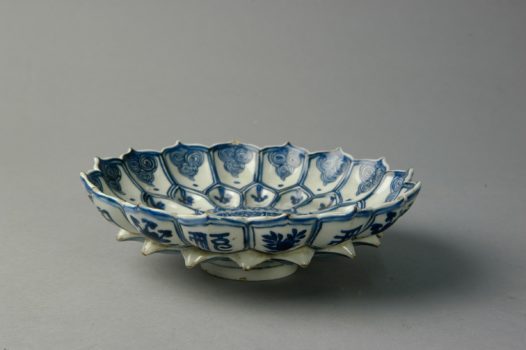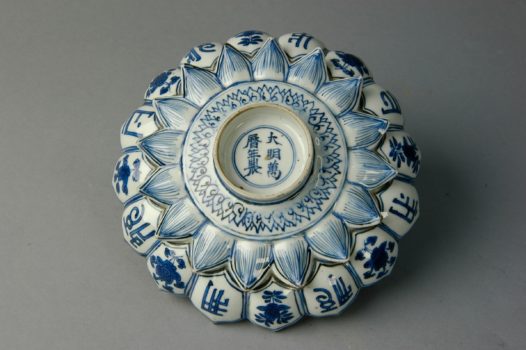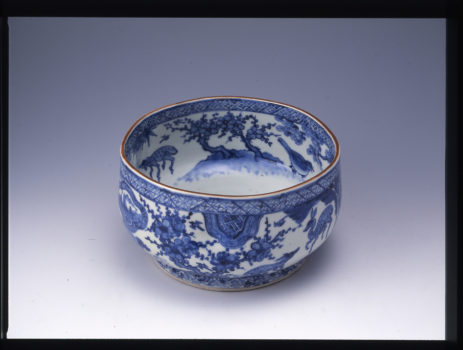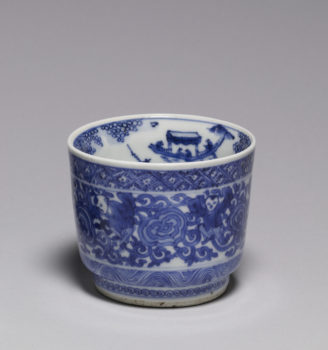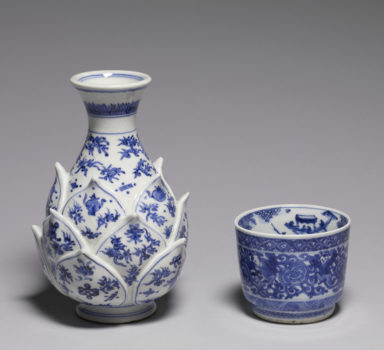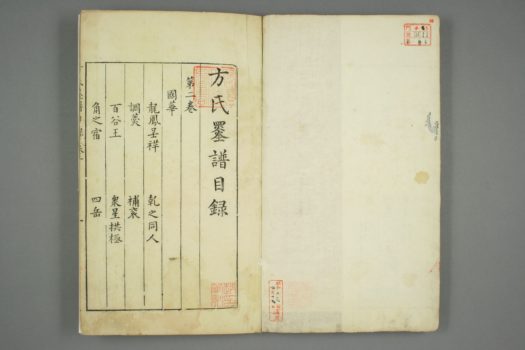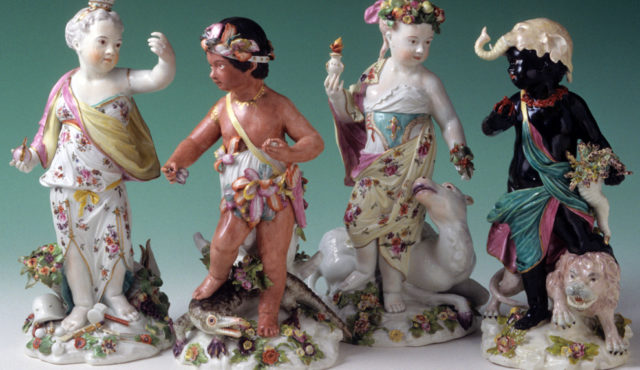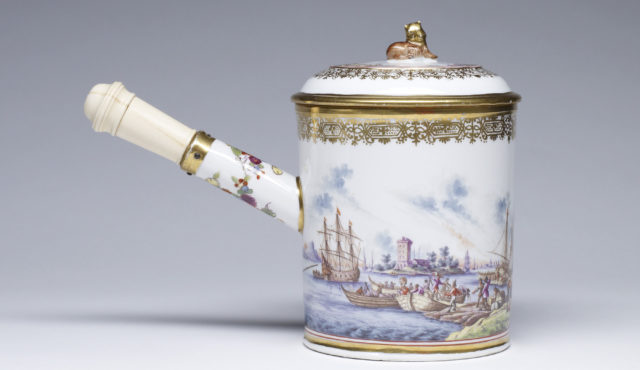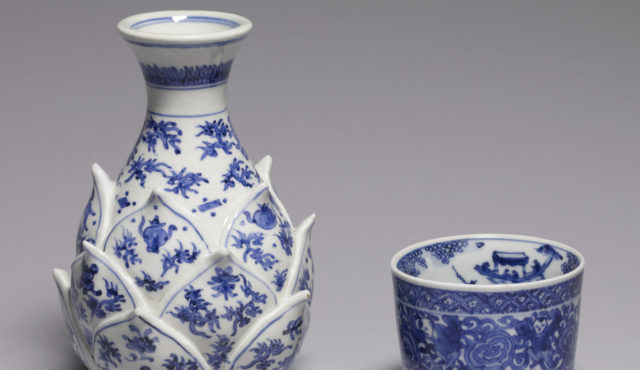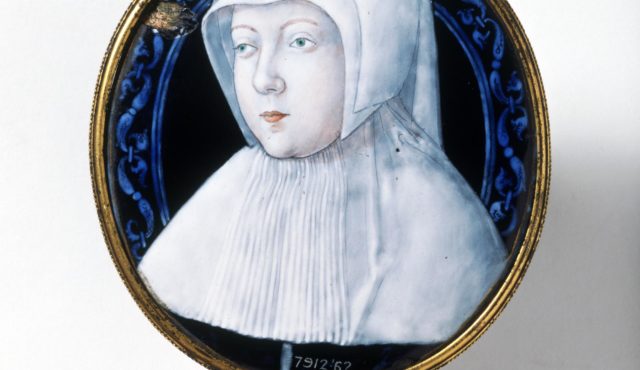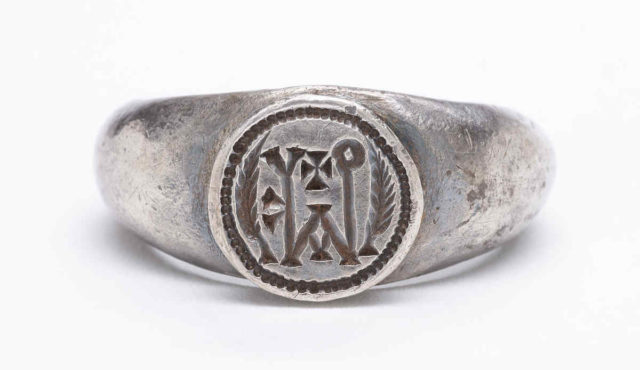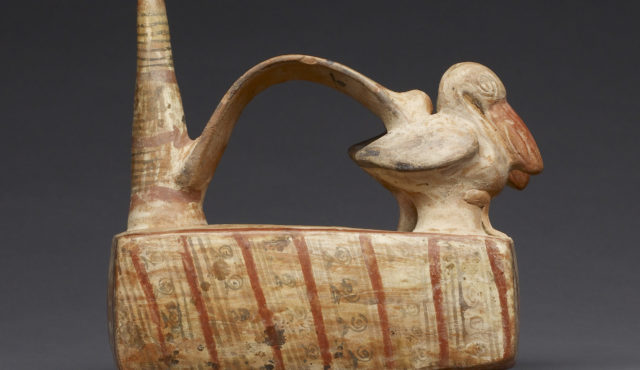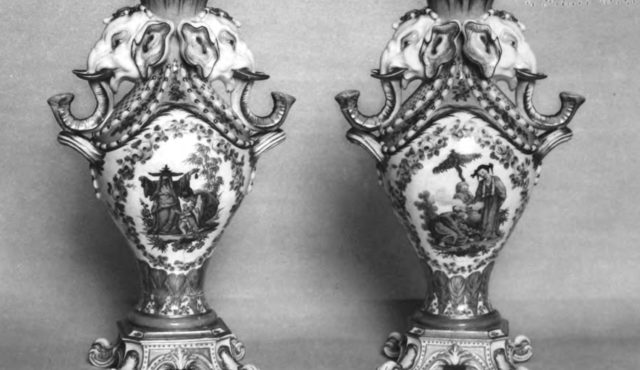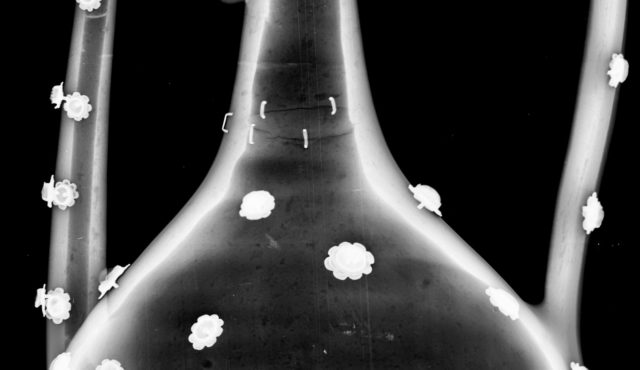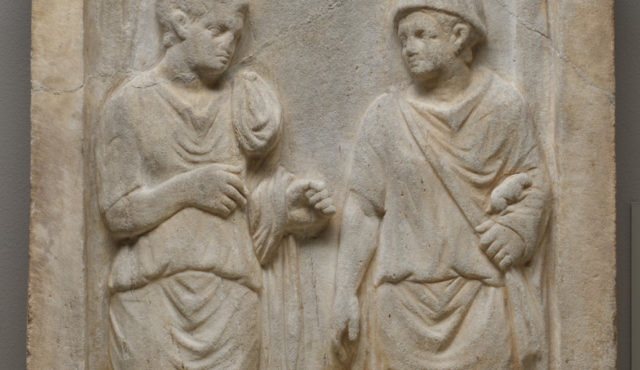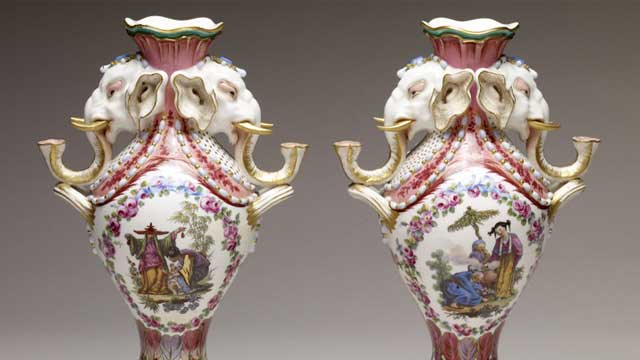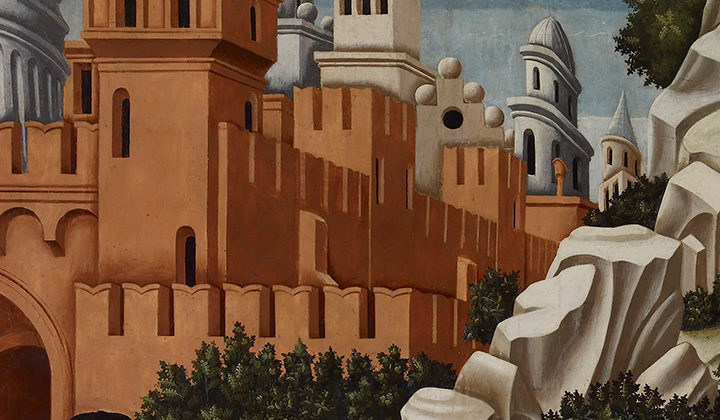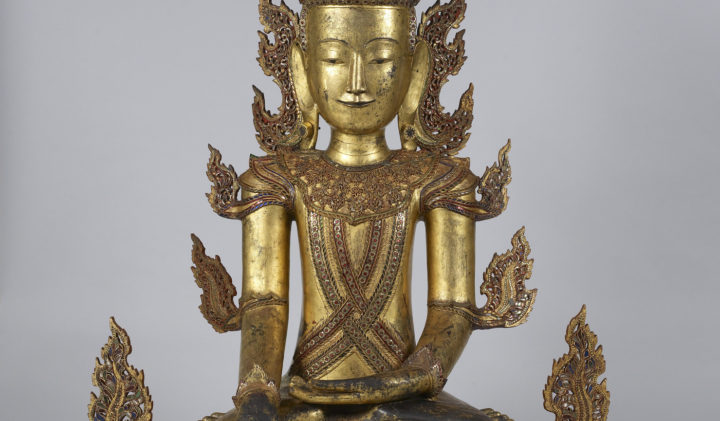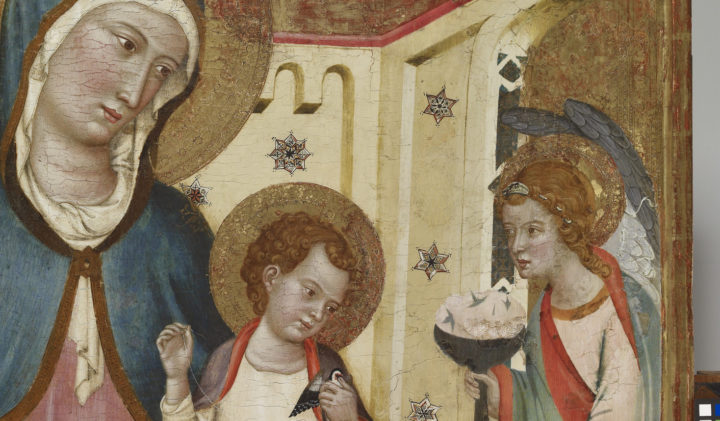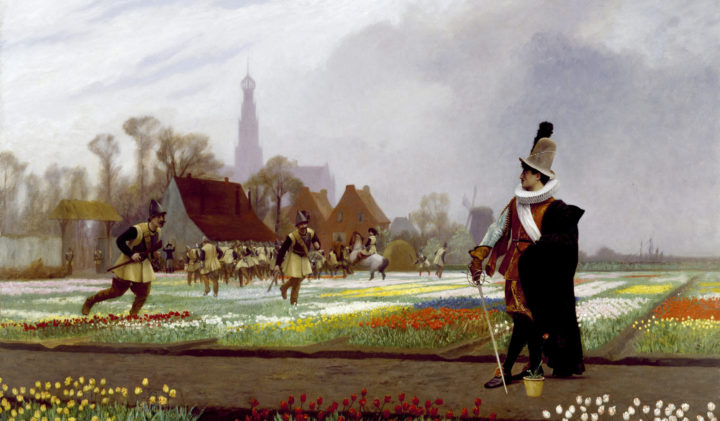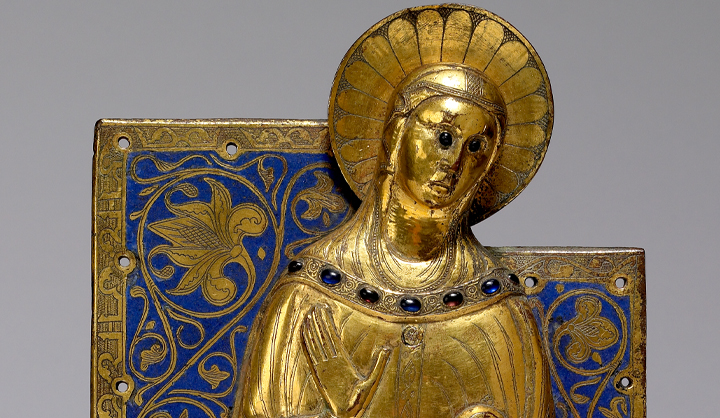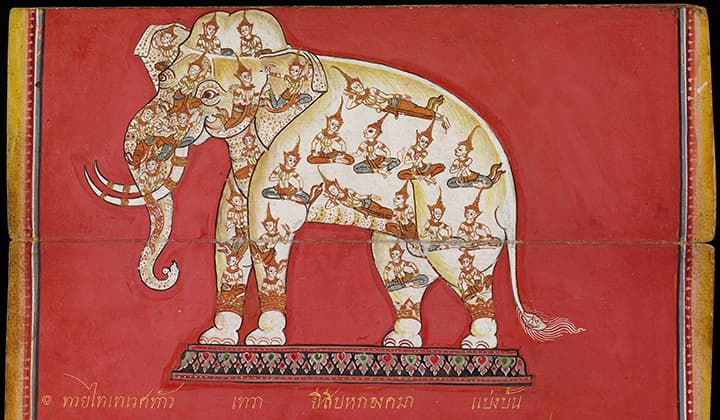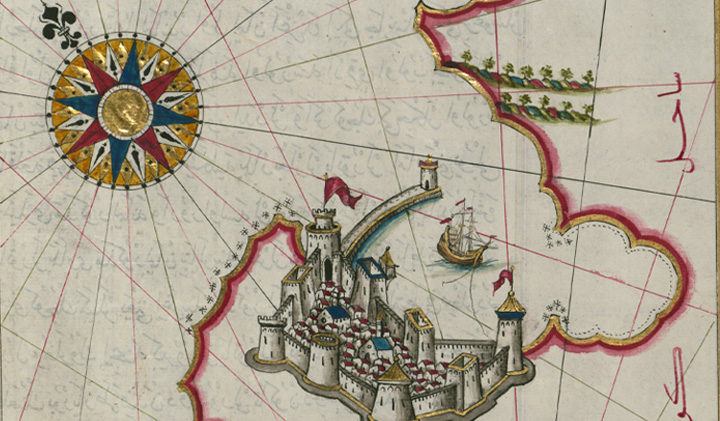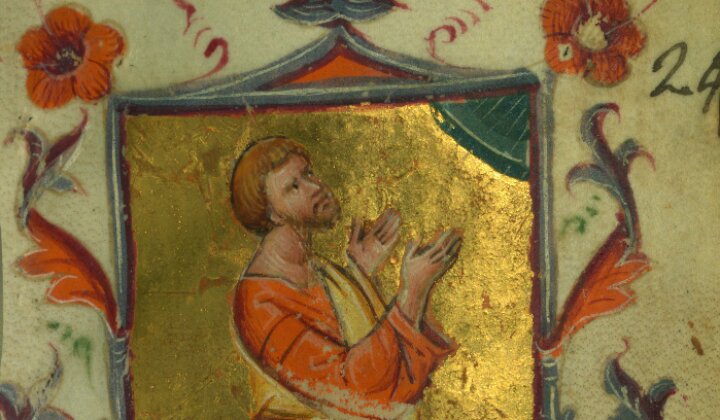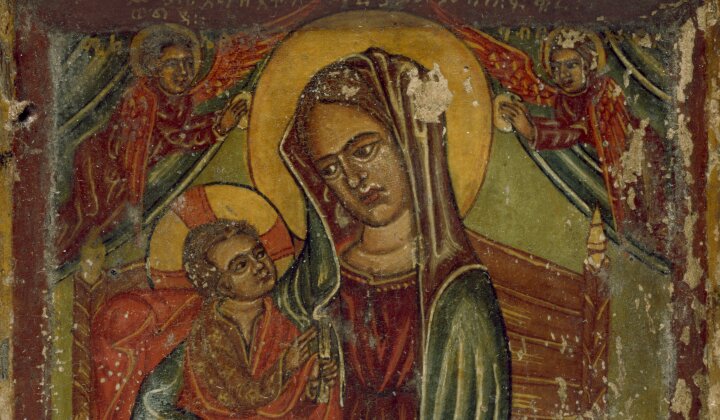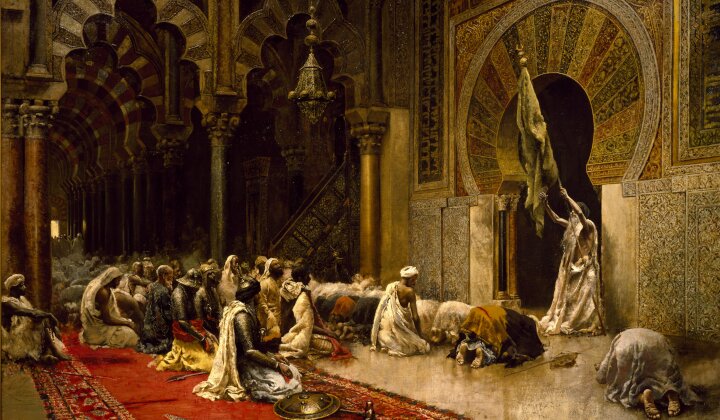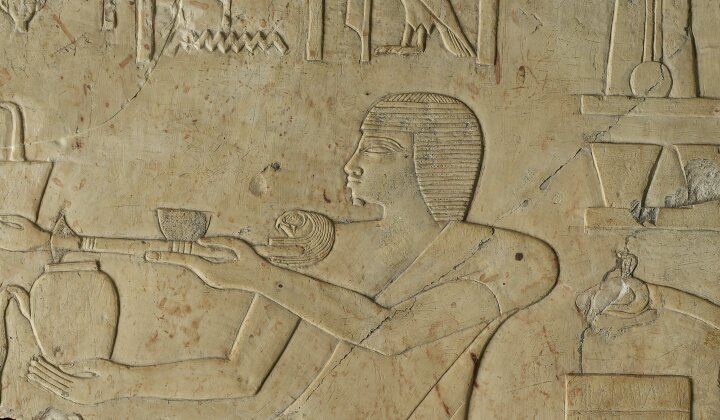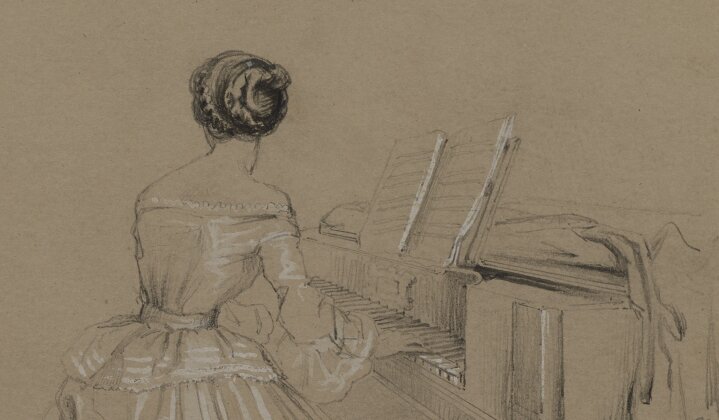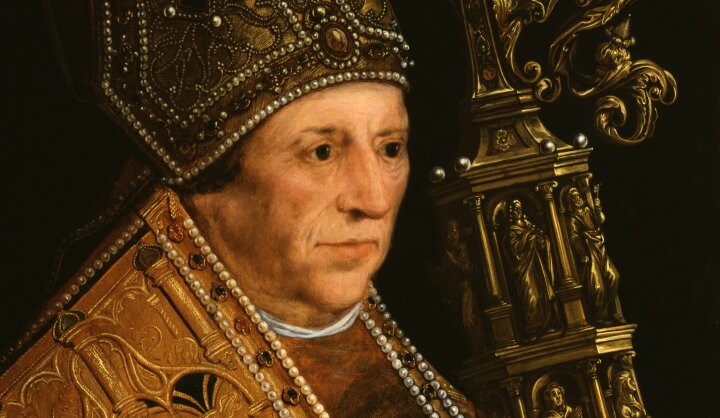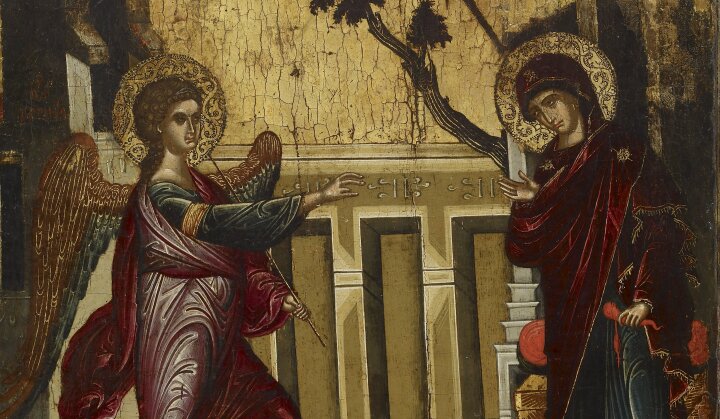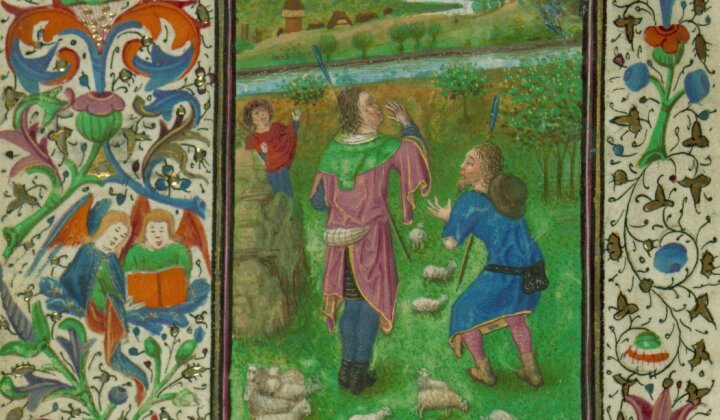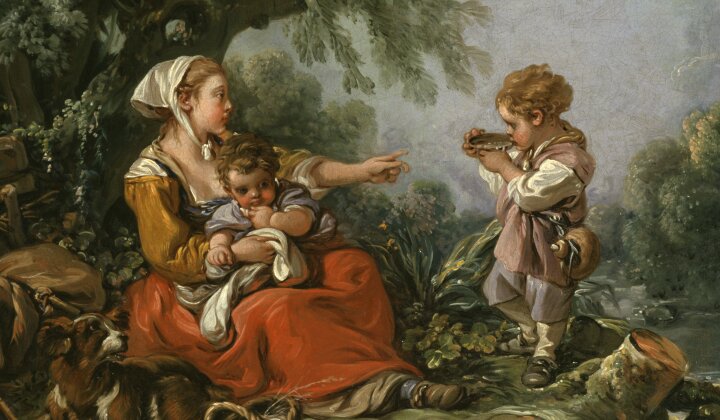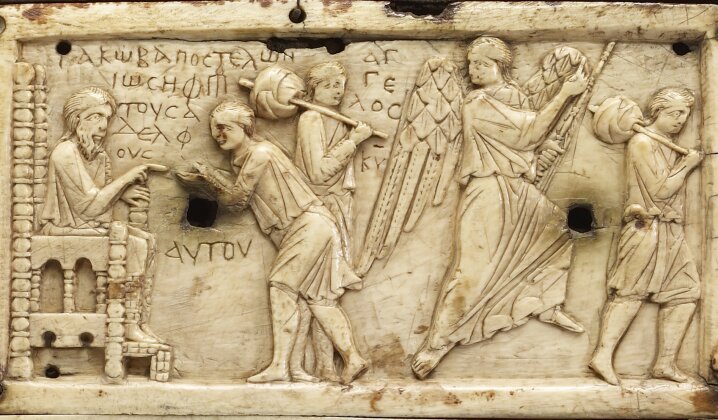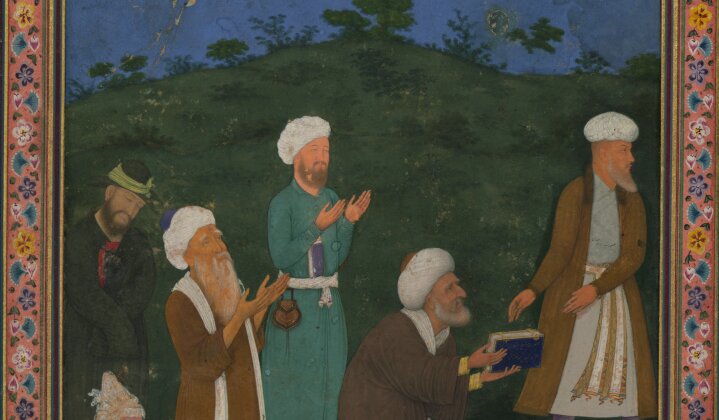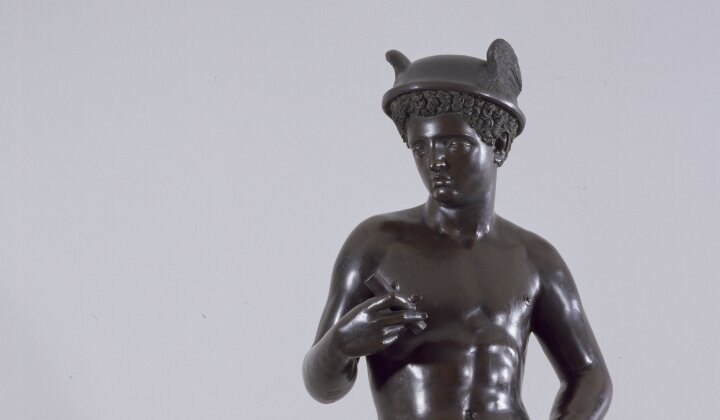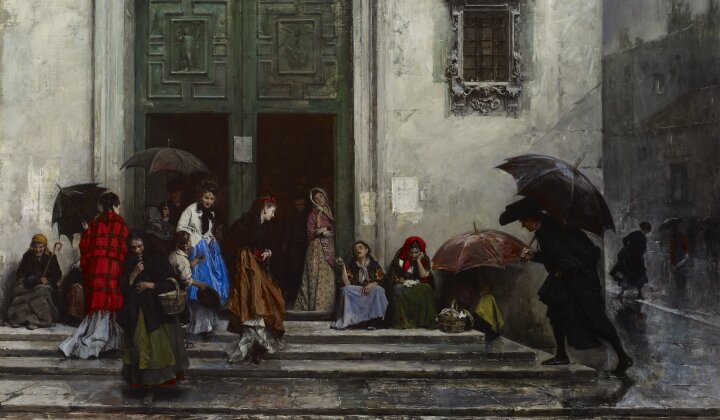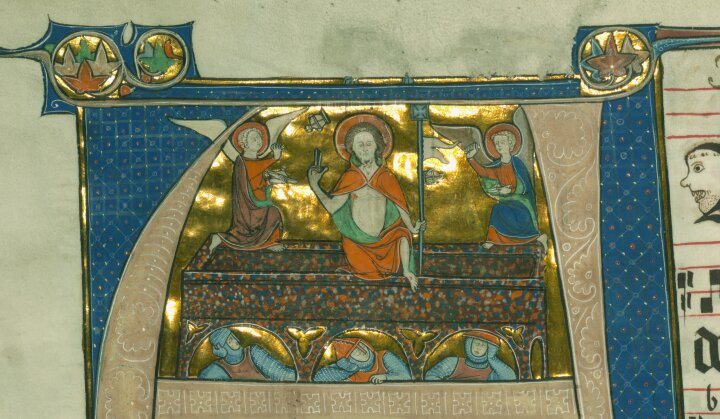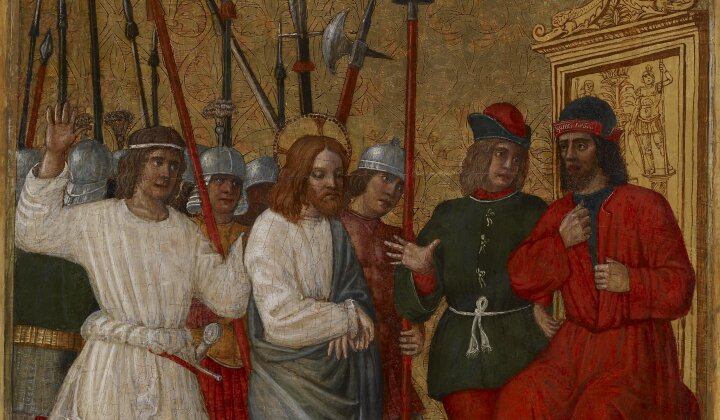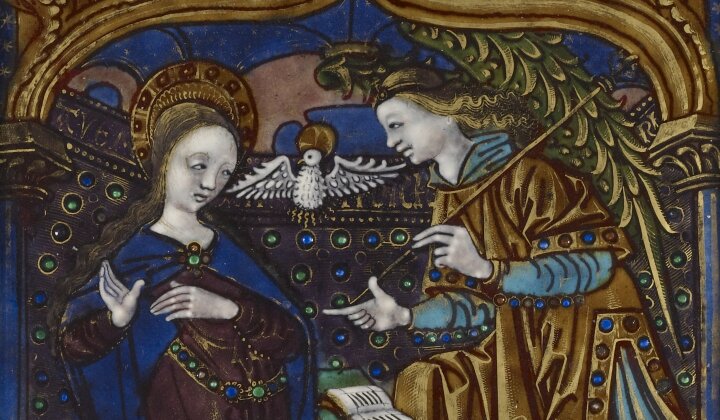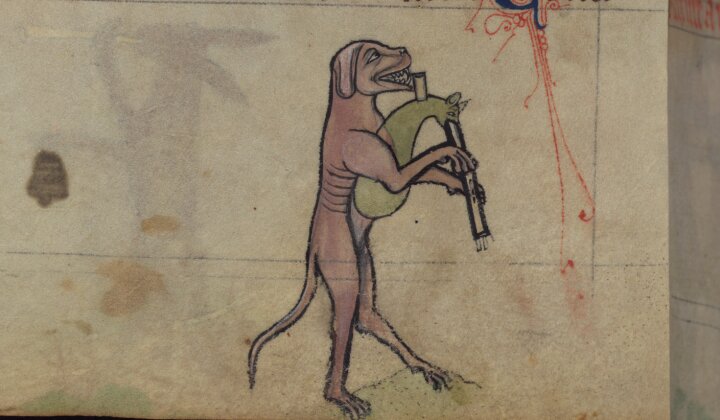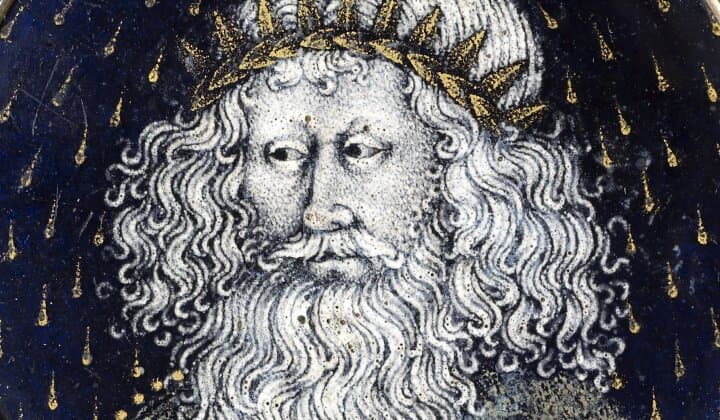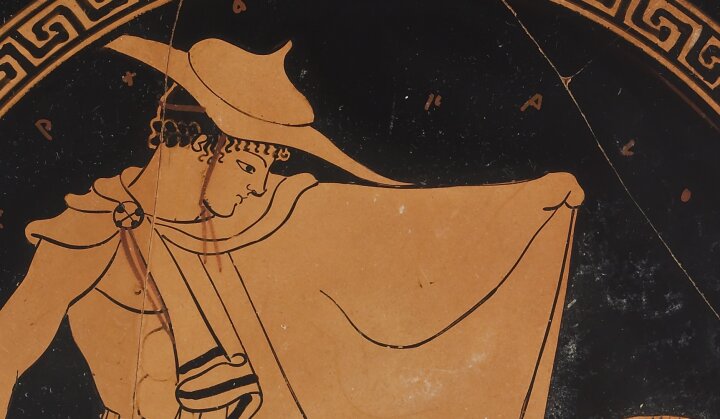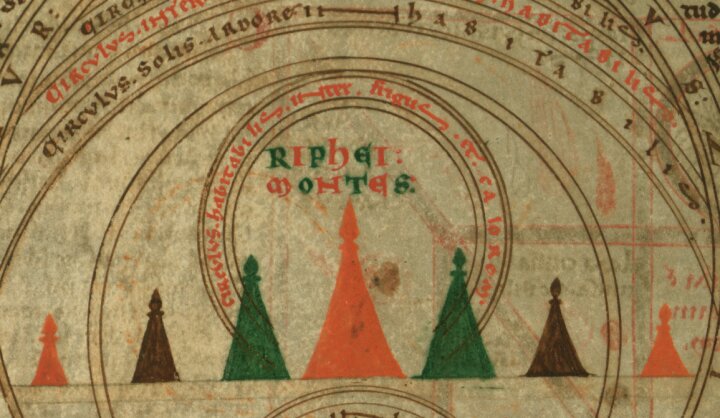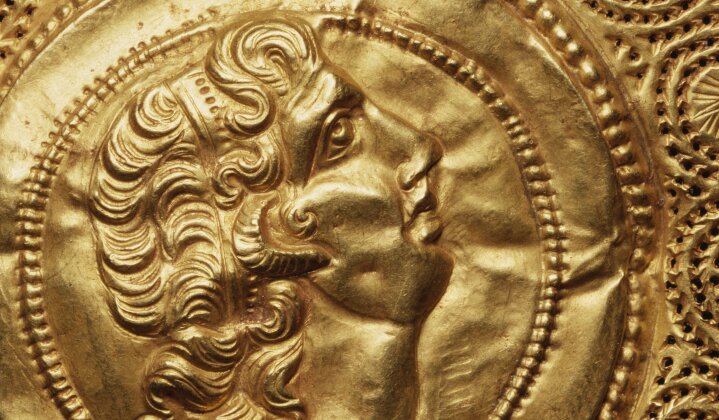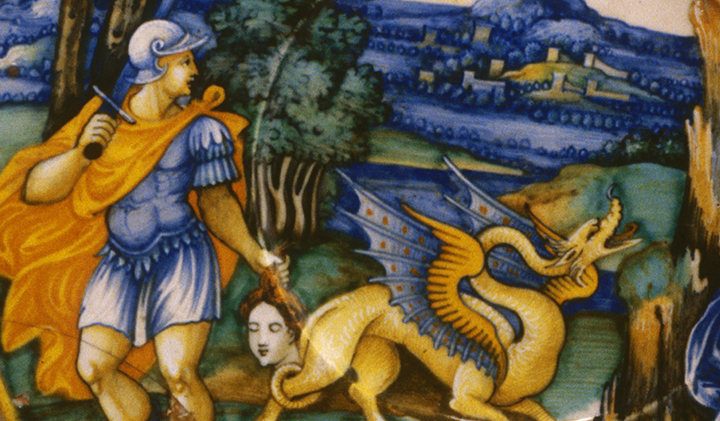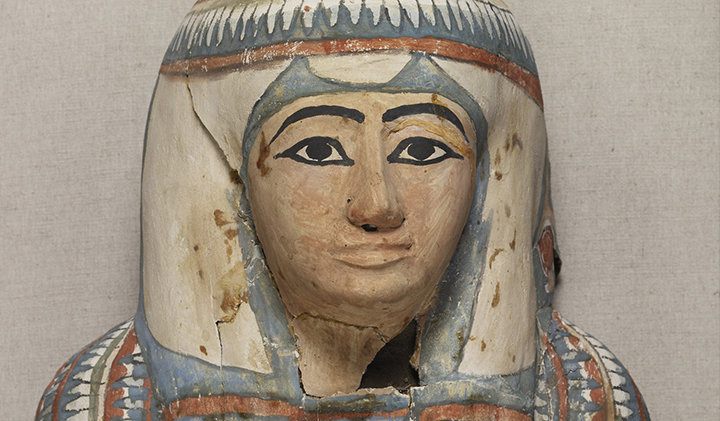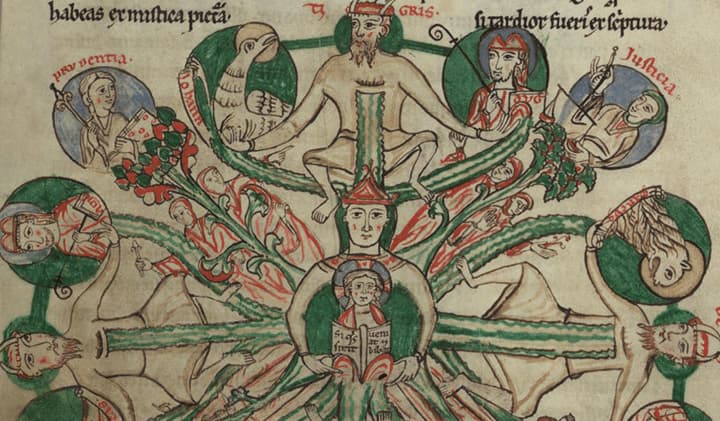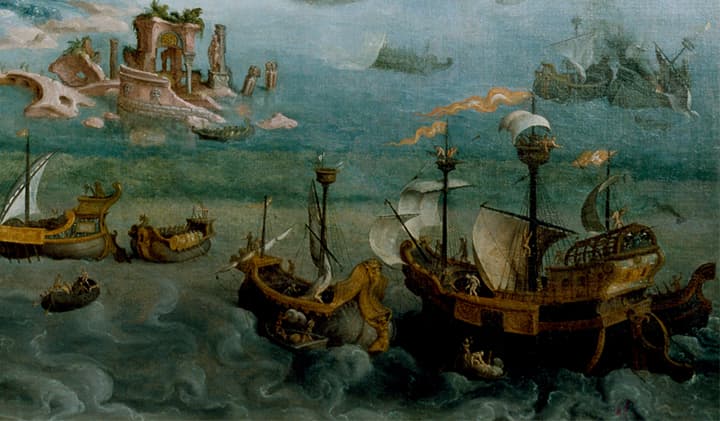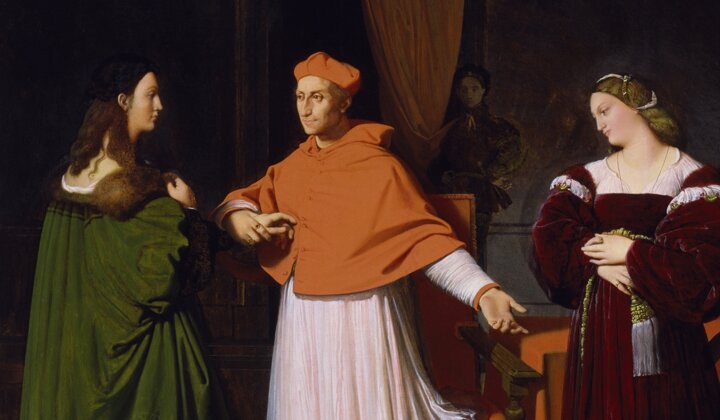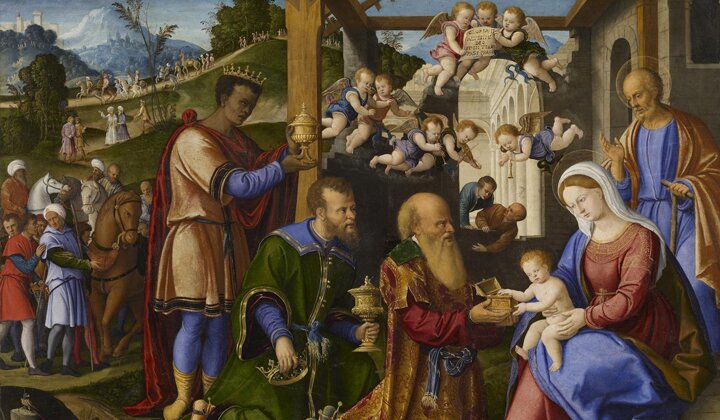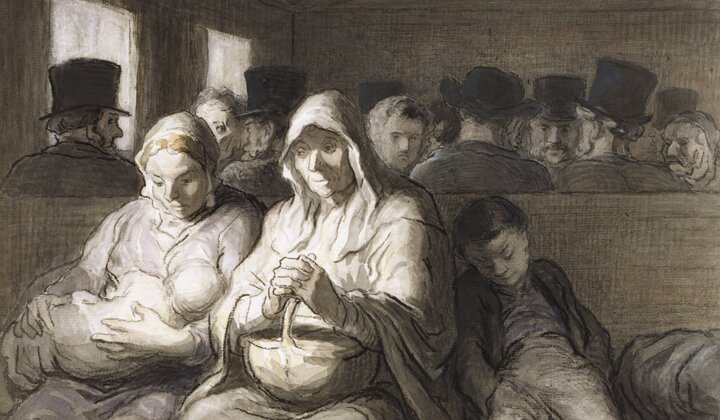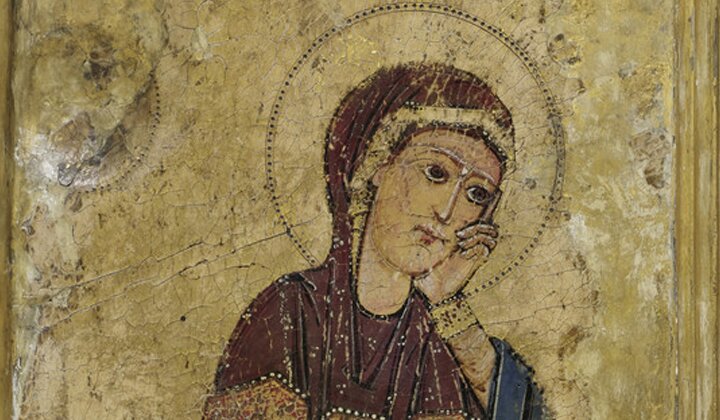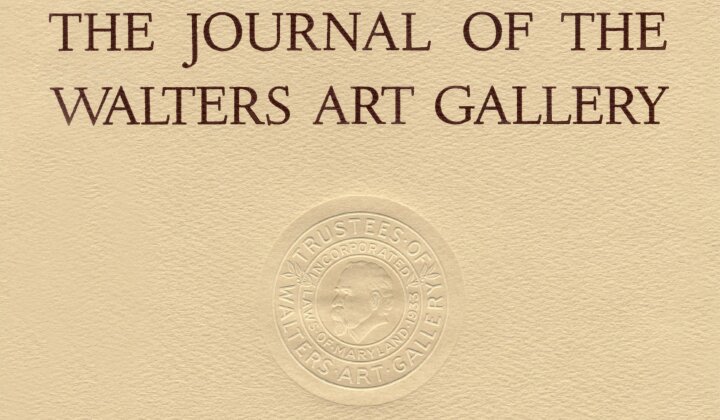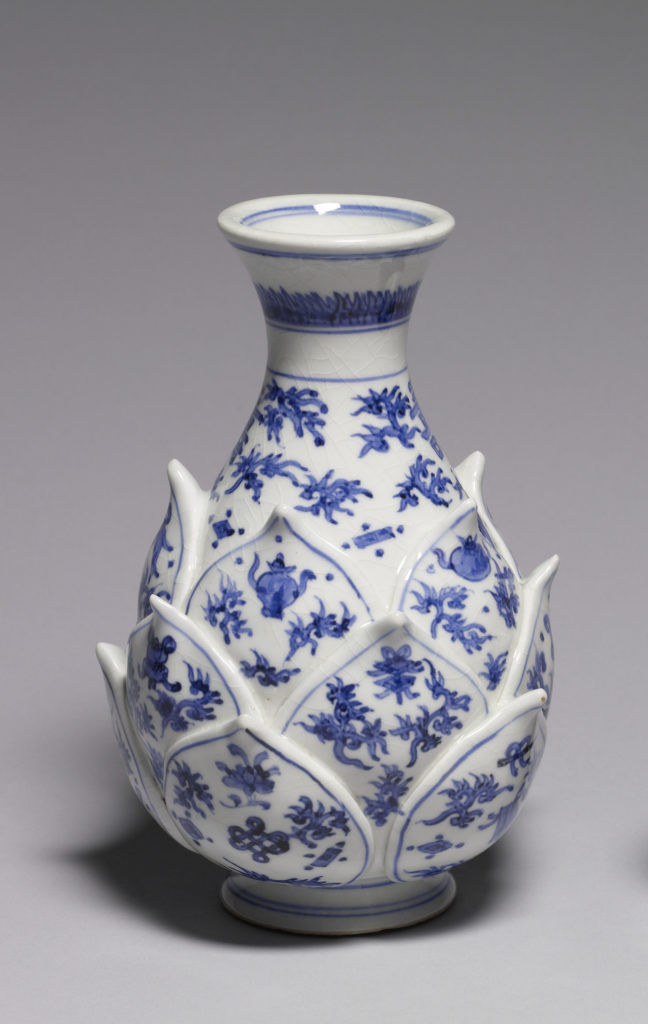
Attributed to Nin’ami Dōhachi (1783–1855), Vase with Lotus Blossom Base, 1825–55, late Edo period, Japan (Kyoto), porcelain with cobalt decoration under clear glaze, H.: 7 5/8 in. (19.4 cm). The Walters Art Museum, Baltimore, Bequest of Henry Walters, 1931, acc. no. 49.1471
In the permanent collection of the Walters Art Museum is a Japanese blue-and-white vase of curious shape (fig. 1). The lower part of the vase takes the form of a lotus blossom, rendered in three tiers of molded “petals” that cover close to two-thirds of the vessel’s surface. Under the vase’s clear glaze, the cobalt decoration comprises scattered auspicious motifs and self-referential images of ceramics. In particular, we see abbreviated representations of tea wares such as kettles (fig. 2) used in the Chinese loose-leaf tea practice known in Japan as sencha 煎茶.
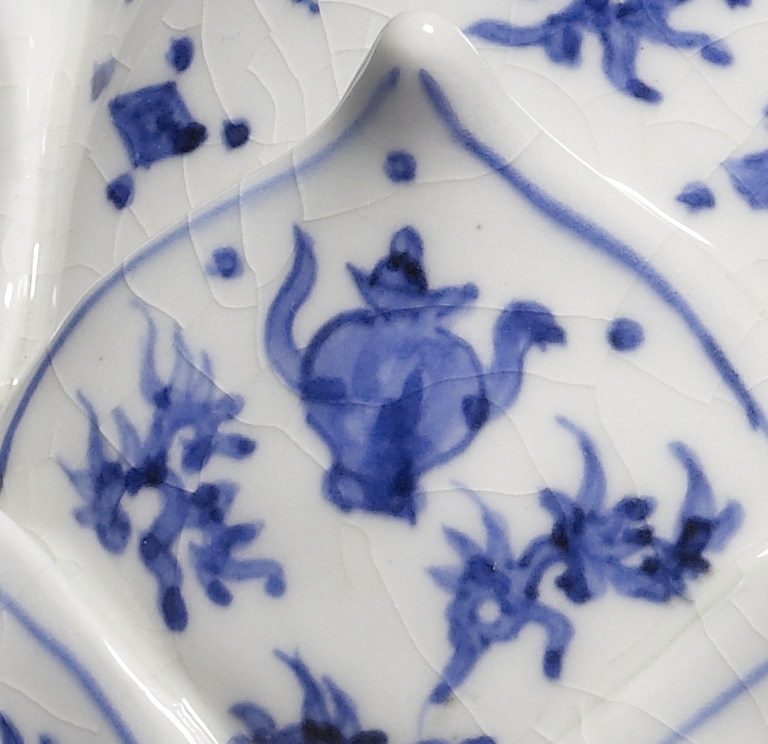
Detail of fig. 1
Literally meaning “steeped tea,” sencha was introduced into Japan in the sixteenth century. It refers to the ritualized practice of preparing and enjoying steeped-leaf tea, as opposed to the older practice of preparing and drinking powdered tea, known as chanoyu 茶の湯 or sadō 茶道. Since its early beginnings in Japan in the fifteenth century, chanoyu has been a driving force in Japanese art and culture; its practice introduced values and aesthetic principles that influenced collecting tastes and shaped new styles of artistic expression in ceramics, design and architecture, and painting.[1] Like chanoyu, sencha became the nexus of ritualized sociability in Japan, and of several privileged types of objects: from paintings displayed in the tea room, to vessels and other implements used for tea preparation and consumption.[2] Objects from China, or Japanese objects that emulated Chinese types, were appreciated in both chanoyu and sencha traditions, however, unlike chanoyu, sencha became, during the Edo period, a Japanese practice most intimately linked to envisioning China. Sencha, in particular, allowed its practitioners to travel, so to speak, not to China per se, but to an aesthetic realm in which Chinese culture was reimagined. Emulation and adaptation of Chinese structures and practices—from legal systems to religious paradigms—had long been established in Japan. During the Edo period, this phenomenon was intensified by several interconnected practices: sencha alongside bunjinga, or painting by artists who were well-versed in Chinese culture and who modeled their lifestyle on that of Chinese literati, and kanshi, or poetry written by Japanese poets in Chinese.[3] Kanshi was integral to both sencha and bunjinga, in the sense that many sencha practitioners and bunjinga painters wrote kanshi, while kanshi poets and calligraphers often provided poems to be displayed in tea rooms or to be inscribed on tea wares. In addition, early in the Edo period (1603–1868), the Tokugawa military government imposed Confucianism—a policy that sparked renewed interest in China.[4] In this context, and as supplies of loose-leaf tea became increasingly available, sencha as cultural practice was a nexus of intellectual and artistic activity that reimagined China in Japan. In particular, sencha objects had complex ties to contemporaneous Ming-dynasty China (1368–1644) and its reinterpretations of the Chinese cultural past. The visual references to tea implements on the surface of the Walters vase suggest that it might have been destined to be used in a space for sencha drinking rituals.
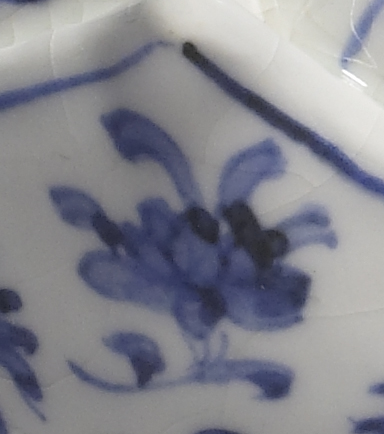
Detail of fig. 1
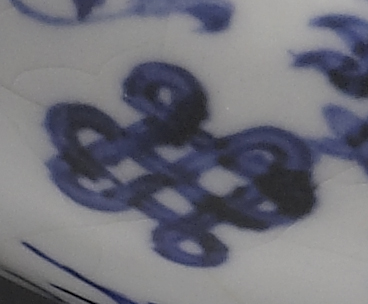
Detail of fig. 1
The inclusion of lotus blossom motifs within the painted decoration of the vase (fig. 3) creates a self-referential link to the shape of the lower half of the vessel. In the same way, representations of tea objects on vases refer to the function of the vases in tea drinking rituals. On the Walters vase, the lotus is depicted alongside the motif of the endless knot (fig. 4); together, these two motifs are part of the eight auspicious symbols of Buddhism: the lotus flower, the endless knot, the conch shell, the pair of golden fish, the bejeweled parasol, the treasure vase, the Wheel of the Law, and the victory banner. These symbols convey various blessings, such as harmony and enlightenment, and are often used in ceramic decoration. The lotus shape representing purity and the endless knot, both belonging to the set of eight auspicious symbols, demonstrate the abundant Buddhist iconography of the vase.
To summarize, the vase has a hybrid decoration comprising two classes of motifs: on the one hand, the self-referential representation of a ceramic object on a ceramic object, indicative of sencha culture and the Edo-period emulation of Chinese models, and on the other hand, the Buddhist auspicious motifs, namely the lotus blossom and the endless knot. All of these themes figured prominently in Edo-period literati (bunjin 文人) circles and their practices of sencha, bunjinga, and kanshi, as detailed above. Therefore, I suggest that the Walters vase is to be understood in this context of the Edo-period literati.
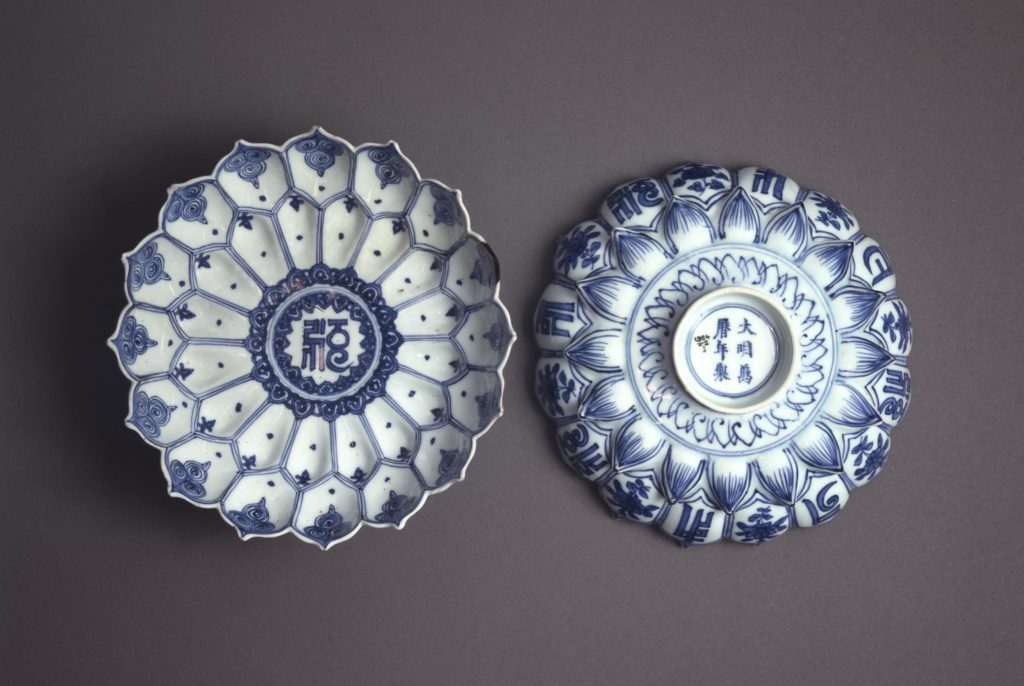
Dish Molded in the Form of a Lotus Flower, China (Jingdezhen), Ming dynasty, Wanli reign, porcelain with underglaze blue decoration, D. x H.: 19 x 5.3 cm. The British Museum, acc. no. 1984,0202.6
Working mostly outside professional schools and official workshops, Japanese literati embraced the Chinese model of sociocultural reclusion and difference that originated in the Qin dynasty (second century BCE), but in the process developed their own traditions and canons.[5] By the time bunjin culture began to consolidate in Japan, especially by the mid-nineteenth century, a core tension had become apparent between the rebellious and the highly individualistic, on the one hand, and the ritualistic and the normative, on the other.[6] At the confluence of these opposing forces was the playfully self-conscious utilization of references to the Chinese past—a practice cultivated through the production and use of objects such as the Walters’ lotus-shaped vase.
A product of the Edo-period cultural practice of adopting and adapting Chinese historical motifs, the Walters vase resembles Chinese porcelains that present the same combination of molded petals and underglaze blue decoration. These porcelains that may have served as inspiration for the Walters vase date from the Ming dynasty, specifically the Wanli reign (1572–1620).[7] A popular subtype of these porcelains is a dish, most likely used as a brush washer for calligraphy, shaped as a lotus, with molded, stylized petals echoed from its base to its rim. There are many known examples of such dishes, some in major museums such as the British Museum and the Henan Museum (figs. 5, 6). These dishes often present Sanskrit inscriptions that emphasize the Buddhist significance of the lotus motif. This stylization of the lotus petal on these Ming-dynasty dishes had long been established in China, harkening back to Tang-dynasty (618–90 CE) bronzes such as lotus-shaped mirrors (fig. 7). With such an established history, this rendition of the lotus motif endured in Chinese visual culture throughout the centuries, including during the Qing dynasty (1644–1912)—the period contemporaneous with the Japanese Edo period that produced the lotus-shaped vase now at the Walters.

Lotus-Shaped Mirror, China, Tang dynasty, 8th century, carved bronze, Diam.: 20.4 cm. The British Museum, acc. no. 1955,0714.2
The Walters vase exemplifies the Edo-period reimagining of older Chinese models. In parallel with this phenomenon in Edo Japan, a similar practice was underway in contemporaneous Qing-dynasty China. Specifically, while Qing-dynasty ceramicists arrived at their own aesthetic solutions to conveying the lotus theme—typically more colorful and naturalistic (fig. 8)— they also imitated earlier Ming-dynasty ceramics such as the lotus-shaped brush-washing dishes. Examples of these Ming-dynasty models would have been available in Japan as ko-sometsuke 古染付, meaning “old blue-and-white,” Chinese porcelain that was imported into Japan from China’s porcelain manufacturing center, Jingdezhen, well before porcelain began to be made in Japan in the early sixteenth century.[8] Perhaps modeled on ko-sometsuke, specifically the brush-washing dish type, the Walters vase is nonetheless grounded in the cultural milieu of its time and place, namely the sencha culture of Edo-period Japan. As such, the aesthetic identity of the vase playfully walks the line between the emulation of Chinese models and the affirmation of an independent interpretive agenda resulting from the potter’s formal and cultural choices.
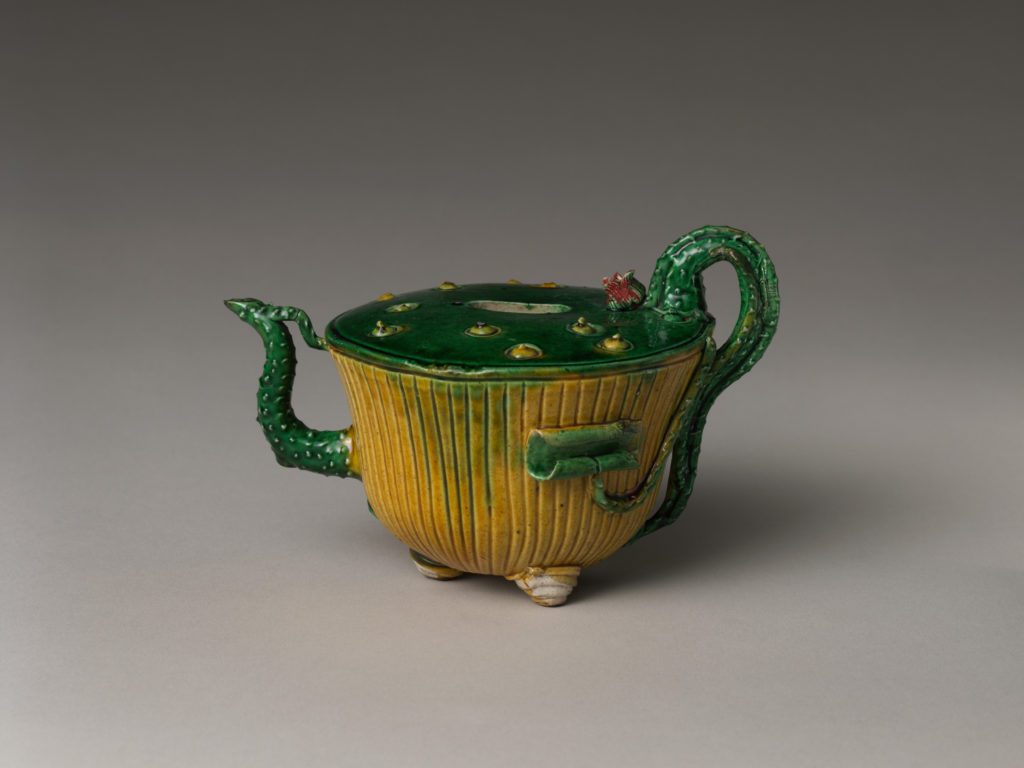
Teapot in Shape of a Lotus Plant, China, Qing dynasty (1644–1911), Kangxi period (1662–1722), ca. 1700, Jingdezhen ware, porcelain with raised and applied decoration under colored glazes, H. to handle: 3 1/2 in. (8.9 cm); W. (max.): 5 3/8 in. (13.7 cm). The Metropolitan Museum of Art, New York, Purchase by subscription, 1879, acc. no. 79.2.1201a, b
This vase emerged from the interconnected realms of tea culture and literati culture, most visibly present in Edo-period Kyoto. The vase’s mark reads Kachūtei Dōhachi sei 華中亭道八製, meaning “made by Kachūtei Dōhachi” (fig. 9). Based on this mark and its Chinese-inspired design, the vase has been attributed to the Kyoto potter Nin’ami Dōhachi (1783–1855).[9] Exceptionally versatile, Dōhachi produced both stoneware and porcelain in a range of Chinese styles. The potter often drew inspiration from the East and Southeast Asian ceramic collections of the Japanese nobility, with whom Dōhachi had close ties and to whom he turned for support in his efforts to revitalize ceramic production in the Kyoto area and beyond.[10] The vase’s lotus motif—so central to Buddhist iconography—would have held special significance for a potter like Dōhachi, who became a lay Buddhist monk in 1824.[11]
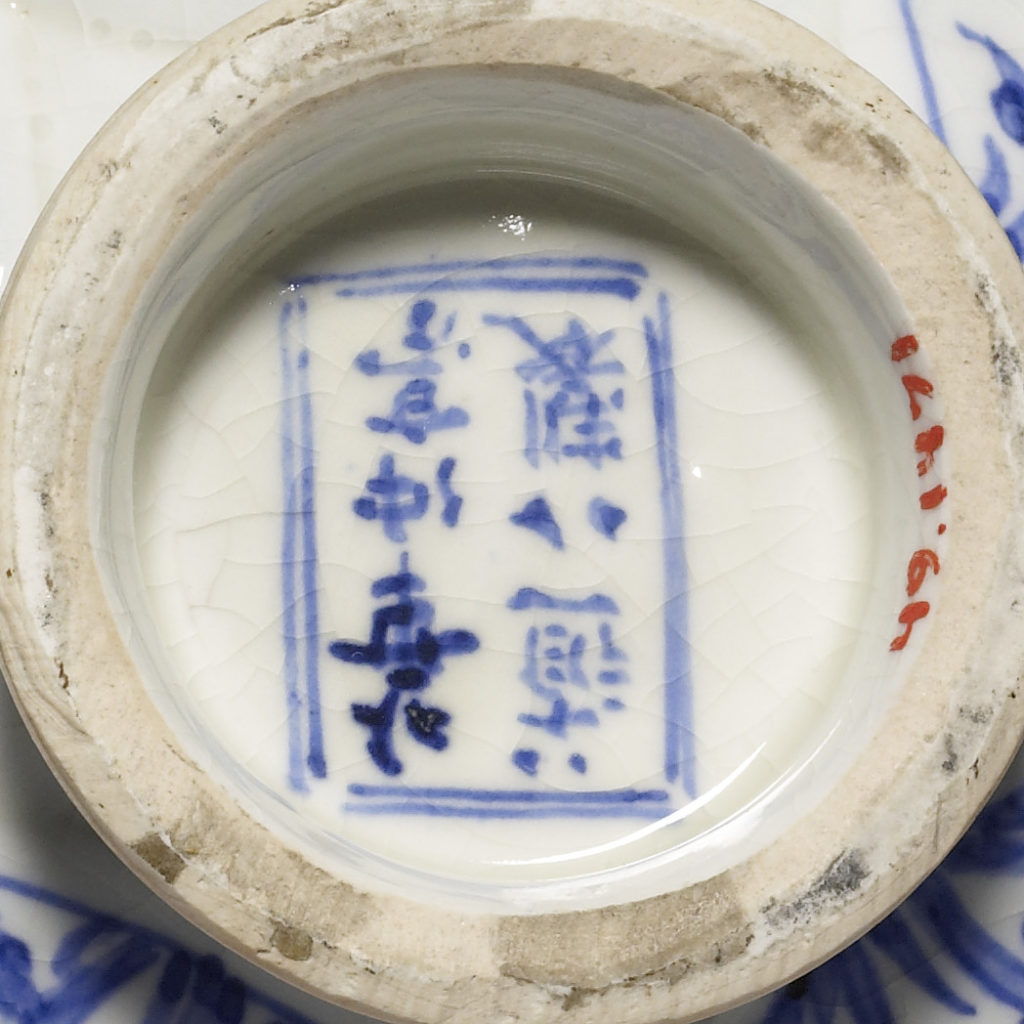
Detail of mark on the bottom of fig. 1.
But the vase’s mark also points to another potter, namely, Dōhachi’s eldest son, Michifusa 光英 (1811–1879), who worked under the sobriquet Kachūtei 華中亭 (just as inscribed on the Walters vase). A third-generation Dōhachi potter, Michifusa followed in his father’s footsteps by starting a new kiln and continuing to produce Chinese-inspired blue-and-white ceramics well into the Meiji period (1868–1912). To illustrate the complexity surrounding attributions of wares by this thriving family of potters (now in its ninth generation), a Chinese-inspired blue-and-white water jar in the British Museum also displays a mark reading Kachūtei Dōhachi sei but rendered slightly differently from the mark on the Walters’ vase (fig. 10). According to Professor Oka Yoshiko, this mark belonged to the fourth-generation Dōhachi (1845–1897), Michifusa’s son, who also used the Kachūtei name.[12] Whether marked by the second- or third-generation Dōhachi, the Walters’ vase epitomizes the enduring presence of reimagining China in the artistic practice of a prolific and influential lineage of Kyoto potters.
Dōhachi (and his descendants) belonged to a larger network of Kyoto-based potters who referred to Chinese models. Notably, Dōhachi’s teacher, Okuda Eisen (1753–1811), had a complex and intimate connection to China. He is thought to have been the grandson of Chinese immigrants who fled to Japan during the turbulent years that marked the end of the Ming dynasty.[13] Born in Japan, Eisen was adopted into the Okuda family and eventually specialized in pottery that emulated the red and brushy Ming-style ceramic design known in Japan as gosu-akae 呉須赤絵. From his early childhood, Eisen may have become familiar with Ming porcelain through exposure to imported Chinese ceramics. In fact, it can be argued that those ceramics came to be better known due to Eisen’s interpretations. Responding to the increasingly popular taste for things Chinese, and to an ever-higher demand for Chinese-inspired wares, Eisen and his disciples helped create a cultural field in which China was reimagined. Their efforts spread beyond the capital as Eisen’s students, Dōhachi included, contributed to establishing ceramic kilns in feudal domains outside Kyoto, thereby disseminating their interrelated styles.[14]
Within these circles, a peer of Dōhachi and a pupil of Eisen was the potter Eiraku Hozen (1785–1854), whose ceramics drew from Ming-dynasty Chinese models, in similar ways to the Walters lotus-shaped vase. An example of Hozen’s work modeled on Chinese porcelain is a ceramic ash container, or takigara-ire 炷空入 (fig. 11), also in the Walters Art Museum (purchased in Paris by William T. Walters at the Exposition Universelle of 1878). This kind of container was used for keeping clean ash for tea ceremonies or for burning incense. Although takigara-ire were made of different materials, including lacquered wood, Hozen’s takigara-ire emulates a seventeenth-century Chinese style of heavily patterned wares known as shonzui. Offering a range of Chinese motifs and scenes on its ceramic surface, Hozen’s shonzui-inspired ash container responded to the Edo-period taste for Chinese porcelain. The intricate decoration of a shonzui-inspired ceramic piece would have complemented wares with fewer motifs, such as the Dōhachi-attributed vase. For centuries, the pairing of objects of strikingly different materials, styles, and textures had been part of the codified but creative practice of toriawase 取り合せ, or the “aesthetics of association,” which entailed the critical comparison of contrasting elements; examples include the combination of prints into a series or the combination of utensils and wares for a tea gathering.[15] In the context of toriawase, Hozen’s ash container and the Dōhachi-attributed vase are both similar, in terms of their emulation of Chinese models, and different, in terms of their decorative styles (displaying a wide range of motifs versus focusing on a few motifs repeated across the vessel’s surface). As objects attributed to potters belonging to the same circle, they illustrate the range of Edo-period porcelain that emulated Chinese models.
The wide-ranging bodies of work of Edo-period potters producing Chinese-inspired ceramics pose challenges for connoisseurs concerned with attribution. For example, among his wares that engage directly with Chinese models alone, Dōhachi produced a variety of sencha ceramics, from vases such as the lotus-shaped one in the Walters—with its delicate underglaze decoration and carefully molded petals—to large unglazed stoves, with rough surfaces decorated in a simple manner with incised motifs derived from Chinese pattern books.[16] The potter’s sources of inspiration are also diverse, and knowledge of which sources were used by individual potters can shed light on issues of attribution and the establishment of a potter’s corpus of work. As shown by curator Kajiyama Hirofumi of the Hyogo Museum of Ceramic Art, Dōhachi drew inspiration from the Ming-dynasty, sixteenth-century Hōshi Bokufu 方氏墨譜, a compendium of inkstick designs, which provided numerous models for Edo-period potters, as well as those working in lacquer (fig. 12).[17] For his sencha stoves, Dōhachi may have transferred patterns from this compendium, thereby manipulating his source material in multiple ways, from resizing to repurposing. In addition, the original Chinese designs for inksticks were transformed into decoration for objects to be used in a Japanese sencha context.
The identification of the Hōshi Bokufu as a source of Chinese shapes and motifs for Dōhachi raises the question of what other types of sources Edo-period potters utilized for their Chinese-inspired wares. Like the Hōshi Bokufu, a number of reference books from China were regarded as canonical, and were distributed widely for study and practice. A notable example is the Jieziyuan Huapu 芥子園畫譜 (Mustard Seed Garden Painting Manual), first published in China in 1679 and introduced to Japan in the early Edo period (1688–1704), exerting an unparalleled influence on literati artists, especially painters.[18] Japanese collectors’ and tea masters’ catalogues of prized possessions—including Chinese and Chinese-inspired Japanese ceramics—also provided resources, as did Chinese and Japanese paintings that included depictions of Chinese ceramics. In addition, Edo-period potters had access, directly or indirectly, to a wide variety of Chinese objects, including ancient Chinese bronzes and jades (especially two-dimensional images thereof), Chinese ceramics from the Song (960–1276) through Qing (1644–1912) dynasties that had traveled to Japan, and Korean and Japanese ceramics modeled on any and all of the above-mentioned sources. Not surprisingly, given the multilayered nature of these available sources, the resulting ceramics were exceptionally rich in cultural references that bridged Japanese and Chinese cultures.
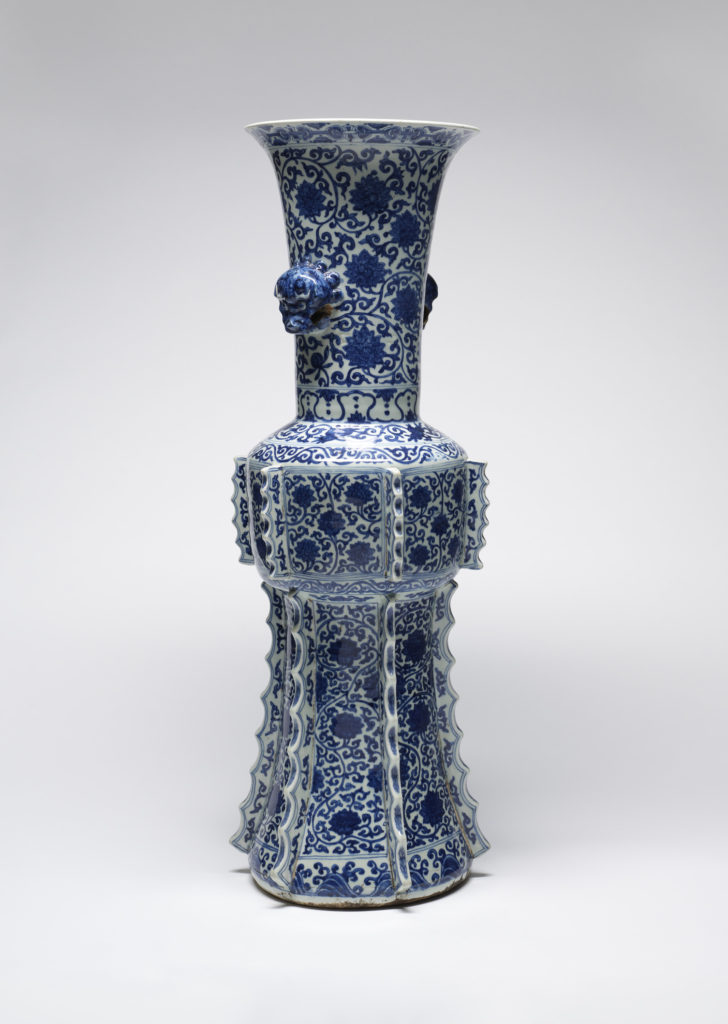
Vase in the Form of an Ancient Bronze Gu, China, Ming dynasty, Wanli reign (1572–1619), underglaze blue porcelain, H: 32 1/2 in. (82.6 cm). The Walters Art Museum, Baltimore, Bequest of Henry Walters, 1931, acc. no. 49.1534
Like many ceramics that emulated Chinese models, the Walters lotus-shaped vase invokes sources from different historical periods, from the Tang to the Ming dynasties. Japanese potters of the Edo period would have had a good sense of the longue durée of central motifs like the lotus blossom in China, if only because of the sources mentioned above. While the model for the Walters vase is more immediately Ming-dynasty, it nonetheless makes reference to an accumulation of cultural uses of the lotus motif harkening back to Chinese antiquity. This practice of referring back to China’s distant past is encountered not only in Japan’s Edo-period literati arts; it had also been, for centuries, a common practice in China to make reference to Chinese art of the distant past.[19] A Chinese Ming-dynasty vase in the Walters Art Museum exemplifies this practice, considering that its shape is modeled on an ancient Chinese bronze vessel type known as a gu (fig. 13).[20] Antiquarianism was at the core of literati circles in both China and Japan. In Ming-dynasty China, as in Edo-period Japan, it entailed an interest in lineages of copies and emulations of the past.
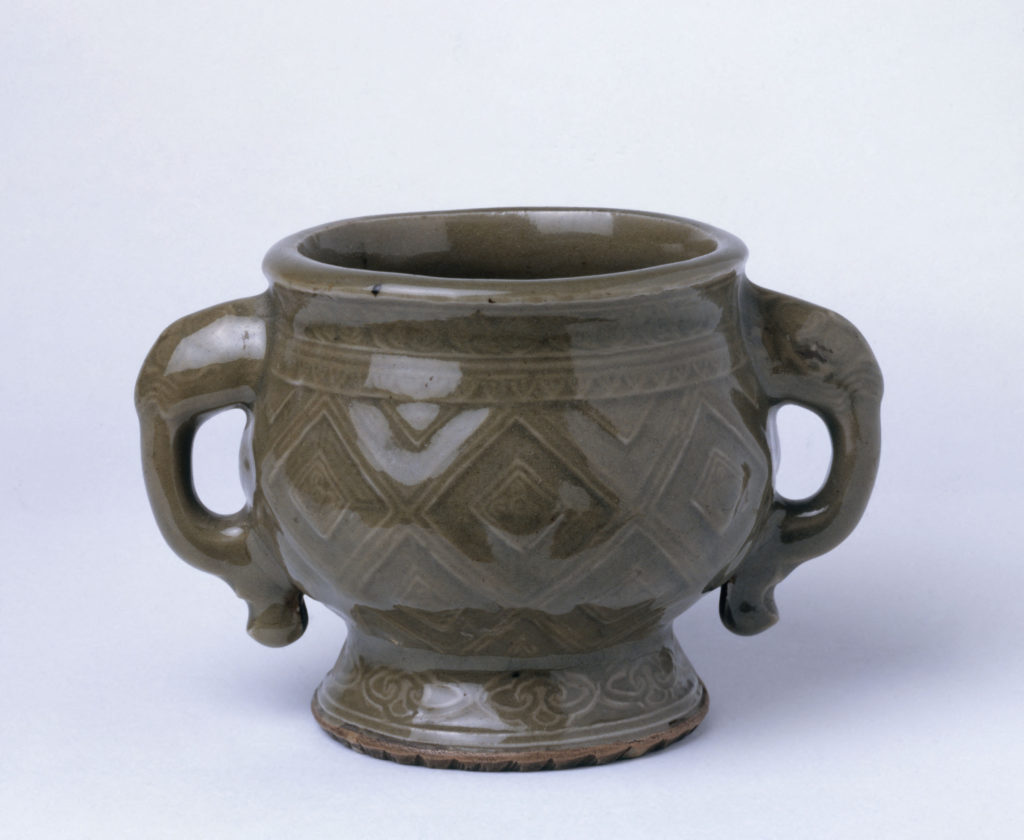
Attributed to Aoki Mokubei (1767–1833), Bowl in the Shape of an Ancient Gui Chinese Vessel, Japan (Kyoto), Edo period (1761–1833), sandstone with celadon glaze. Cernuschi Museum, Paris, Bequest of H. Cernuschi, 1896
A peer of Dōhachi and fellow disciple of Okuda Eisen, the Kyoto-based potter Aoki Mokubei (1767–1833) created Chinese-inspired tea wares that engaged with the Chinese practice of making versions of things of the past. A bowl attributed to Mokubei, now in the Cernuschi Museum in Paris (fig. 14), is modeled on an ancient, Shang-dynasty ritual vessel type known as a gui.[21] However, as noted by curator Michel Maucuer, the lingzhi mushroom design on the base of this bowl dates from a later period in Chinese history and is thereby anachronistic.[22] Both the Dōhachi vase in the Walters and the Mokubei bowl in the Cernuschi include subtle references to this mise en abyme of archaizing versions. According to a source from 1804, Mokubei was interested in ancient and old objects because they testified to the heyday and the decline of successive political eras.[23] This mode of thinking may have encouraged cross-temporal reflections on culture and society—translated, materially, into hybrid objects that simultaneously evoke multiple eras and thereby defy a linear historicist model.
Various levels of emulation can be found at work in Chinese-inspired Japanese ceramics: on the one hand, the emulation of another culture, through the exercise of invoking China and interpreting Chinese cultural elements; on the other hand, the emulation of the past, particularly as manifested in antiquarianism and the mix of references to different interrelated eras. In emulating Chinese models from the past, at times, Japanese potters also used the ceramic medium to imitate other materials such as vegetal and animal forms, wood, bronze, and jade. In the case of the Walters lotus-shaped vase, the potter set out to emulate Chinese models, especially lotus-themed ceramics of the Ming dynasty, but with an antiquarian’s interest in the longevity of this particular stylization of the lotus petal, harkening back to the Tang dynasty. Putting skill on display, the potter also embedded a playful reference to the popular practice—in both Japan and China—of imitating vegetal forms in the ceramic medium.
At the end of the nineteenth century, upon entering the collection of William T. and Henry Walters, the lotus-shaped vase became part and parcel of an international revival of interest in the Chinese past. The aforementioned antiquarianism of Chinese and Japanese literati found its match in a handful of European and American collectors of East Asian art, whose wide-ranging, if oftentimes surface-level, explorations of this vast field of knowledge came to include an interest in Edo-period ceramic interpretations of ancient Chinese forms and motifs. Since the early 1870s, collectors in the West became aware of the Japanese practice of emulating Chinese bronzes and porcelain, even though their knowledge of specific periods and layers of imitation remained limited.
For William and Henry Walters and other collectors of their generation, there were four main sources of both objects and knowledge: first, the World’s Fairs, from which the Walters father and son made the majority of their purchases; second, major private dealers like Yamanaka & Co., who set trends and influenced what types of Japanese art were available on international markets; third, European and American lay cultural historians like Edward Sylvester Morse, whose paradigms about Japanese arts—however incomplete or inaccurate—set a standard for collectors who had limited or no access to Japanese sources; and fourth, scholars like Okakura Kakuzō and Ernest Fenollosa, who were writing and publishing, in English, on various topics in Japanese art, culture, and history. Some collectors, like Henri Cernuschi (who purchased the Mokubei bowl shown in fig. 14) and Emile Guimet in France or Charles Lang Freer in the United States—and perhaps William and Henry Walters, too, as the purchase of this vase would indicate—were attracted to Chinese-style Japanese ceramics and their antiquarian distancing, as it were, manifested via references to both another country and that country’s past.
For Euro-American collectors in the late nineteenth century, objects like the Walters lotus-shaped vase epitomized the Japanese literati taste for things Chinese and represented desirable tokens of the cross-cultural imagination of Edo-period Japan.A closer look at market trends and collector tastes—both at the time of the object’s production and at the time of its purchase—can shed new light on how artistic and cultural milieux informed potters’ output and the formation of their reputations in the increasingly global art world of the late nineteenth century. Specifically, as this essay has suggested, the multi-tiered emulation of China in Edo-period Japan is far from a single episode in the history of Japanese material culture, but a playfully knowing, intellectually rich artistic practice that continued to inspire artists and collectors, within local, cross-cultural, and global contexts.
[1] The literature on chanoyu is vast and wide-ranging. References include: H. Paul Varley and Isao Kumakura, Tea in Japan: Essays on the History of Chanoyu (Honolulu: University of Hawai’i Press, 1989); Andrew Watsky, Chikubushima: Deploying the Sacred Arts in Momoyama Japan (Seattle: University of Washington Press, 2004).
[2] For an excellent analysis of sencha culture and ceramics, see Patricia Graham, Tea of the Sages: the Art of Sencha (Honolulu: University of Hawai’i Press, 1998).
[3] The literature on the intersection of sencha, bunjinga, and kanshi is vast, including Paul Berry and Michiyo Morioka, Literati modern: Bunjinga from Late Edo to Twentieth-Century Japan (Honolulu: Honolulu Academy of Arts, 2008) and Sino-Japanese Studies 11–13 (1998–2001). See also the compelling analysis of this complex topic in Atsuko Sakaki, Obsessions with the Sino-Japanese Polarity in Japanese Literature (Honolulu: University of Hawai’i Press, 2005).
[4] See Peter Nosco, Confucianism and Tokugawa Culture (Princeton: Princeton University Press, 1989).
[5] For a thorough account of the practice and portrayal of reclusion in early Chinese history, see Alan J. Berkowitz, Joachim Raff, and Richard Edlinger, Patterns of Disengagement: The Practice and Portrayal of Reclusion in Early Medieval China (Stanford: Stanford University Press, 2000).
[6] Kendall Brown, The Politics of Reclusion: Painting and Power in Momoyama Japan (Honolulu: University of Hawai’i, 1997), 71–72.
[7] On Ming culture and the Wanli reign, see Dora C. Y. Ching, Chu Hung-Iam, and Scarlett Jang, Culture, Courtiers, and Competition: The Ming Court (1368–1644), ed. David Robinson (Cambridge, MA: Harvard University Asia Center, 2008). On Ming-dynasty porcelain, see Louise Allison Cort and Jan Stuart, Joined Colors: Decoration and Meaning in Chinese Porcelain (Washington, DC: Smithsonian Institution, 1993).
[8] “Playing with Ko-sometsuke: Chinese Blue-and-White in the Late Ming Dynasty,” exhibition wall literature, Museum of Oriental Ceramics, Osaka, August 2–28, 2011. For a thorough review of Chinese blue-and-white porcelain imported in Japan prior to the birth of Japanese porcelain, see Julia B. Curtis, Trade, Taste & Transformation: Jingdezhen Porcelain for Japan, 1620–1645 (New York: China Institute, 2006). For a wider lens, see Sadako Ohki and Takeshi Watanabe, Tea Culture of Japan (New Haven: Yale University Press, 2009).
[9] Louise Allison Cort, “Collecting against the Grain: Unexpected Japanese Ceramics in the Collection of the Walters Art Museum.” The Journal of the Walters Art Museum, 64/65, 2006, 190.
[10] Louise Allison Cort, Seto and Mino Ceramics (Washington, DC: Smithsonian Institution, 1992), 194; Kodansha Encyclopedia of Japan (Tokyo: Kodansha, 1983), 20:4.
[11] See, among other sources, Nancy Schiffer, Japanese Porcelain, 1800–1950 (Atglen, PA: Schiffer Publishing, 1986), 228.
[12] Curatorial notes for Japanese water jar donated by Sir Augustus Wollaston Franks, British Museum, department of Asian art, bibliographic reference Edo BM 1982 281.
[13] Patricia Jane Graham, Tea of the Sages: The Art of Sencha (Honolulu: University of Hawai’i Press, 1998), 124–27.
[14] “Kyoto Ware Potters of the Late Edo Period: Okuda Eisen and His Pupils”, exhibition wall literature, Tokyo National Museum, February 6–April 22, 2018.
[15] Ichirō Ishida and Delmer M. Brown, “Zen Buddhism and Muromachi Art,” Journal of Asian Studies 22, no. 4 (1963): 424. On toriawase in the context of tea, see, among other sources, Christine Guth, Art, Tea, and Industry: Masuda Takashi and the Mitsui Circle (Princeton: Princeton University Press, 1993). On toriawase as material selection for Japanese scrolls, see William De Lange and Teruo Takayanagi, Japanese Scrolls: Their History, Art, and Craft (Warren, CT: Floating World Editions, 2016). On a similar practice in Japanese poetry, see Clifton W. Royston, “Utaawase Judgments as Poetry Criticism,” Journal of Asian Studies 34, no. 1 (1974).
[16] On the incised motifs on Dōhachi’s ceramics and their sources, see Kajiyama Hirofumi, “Tōjiki seisaku ni okeru hanpon shahon no riyō nitsuite: Edo kōki no Kyōyaki wo chūshin ni” 陶磁器制作における版本・写本の利用について : 江戶後期の京焼を中心に / 梶山博史著, Kajima Bijutsu Zaidan 鹿島美術財団, Kajima bijutsu kenkyū 鹿島美術研究 series, vol. 32, Tokyo, 2015, 176–87.
[17] Ibid.
[18] Mai-mai Sze, The Tao of Painting, a Study of the Ritual Disposition of Chinese Painting; with a Translation of the Chieh Tzŭ Yüan Hua Chuan; or, Mustard Seed Garden Manual of Painting, 1679–1701 (New York: Pantheon Books, 1956). On the influence of the manual on Japanese literati painting, see, for example, Melinda Takeuchi, “‘True’ Views: Taiga’s Shinkeizu and the Evolution of Literati Painting Theory in Japan,” Journal of Asian Studies 48, no. 1 (1989).
[19] See Wu Hung, Reinventing the Past: Archaism and Antiquarianism in Chinese Art and Visual Culture (Chicago: Center for the Art of East Asia, University of Chicago, 2010), in particular the chapter by Martin Powers, “Imitation and Reference in China’s Pictorial Tradition.” See also the recent publication of Yunchiahn C. Sena, Bronze and Stone: The Cult of Antiquity in Song Dynasty China (Seattle: University of Washington Press, 2019), especially Chapter 3, “Archaistic objects and Song material culture,” which explores the “translation” of ancient Chinese bronzes through ceramic (porcelain) interpretations.
[20] For examples of ancient bronze gu, see: Gu, twelfth–eleventh century BCE, acc. no. F1943.9, Freer Gallery of Art ( https://asia.si.edu/object/F1943.9/) and Ritual Wine Beaker (Gu), late eleventh century BCE, acc. no. 24.72.10, Metropolitan Museum of Art (https://www.metmuseum.org/art/collection/search/42173).
[21] For an example of an ancient bronze gui, see: Food Serving Vessel (Gui), twelfth century BCE, acc. no. 62.217, Metropolitan Museum of Art (https://www.metmuseum.org/art/collection/search/44617).
[22] Curatorial notes for bowl in the shape of ancient Chinese bronze vessel, attributed to Aoki Mokubei, object no. M.C. 4228. Curator Michel Maucuer. Cernuschi Museum, Paris.
[23] Ibid.
